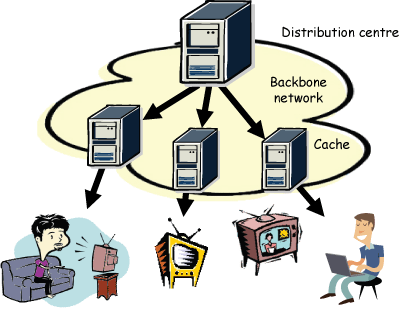by Henrik Abrahamsson and Per Kreuger
As part of the SICS Center for Networked Systems we investigate new and efficient ways of distributing television over the Internet Protocol.

IPTV, where television is distributed over the Internet Protocol (IP) in a single operator network, has now become reality. Several large telephone companies have become TV providers including AT&T U-verse, Verizon Communications, Deutsche Telekom, TeliaSonera, British Telecom and China Telecom. It is estimated that there are about fifty IPTV operators today with more than 10 million subscribers, and that these figures will increase significantly in the near future.
The TV services provided often include tens of TV channels, sometimes high-definition TV, and video on demand (VoD). While most operators distribute the TV channels over their backbone network as continuous streams, they also often employ a system of peripheral storage devices (caches) located closer to the customers, for time-shift TV and for more permanent storage of popular VoD content.
Most of the programs we see are pre-recorded, with only a small percentage being sent live. Some are recorded the same day, while most are ready for distribution well before they are shown. Many channels also show a lot of reruns, with prime-time programs being shown again during the night or the next day.
If we regard the TV programs as individual information objects (rather than just part of a streamed channel), the reruns could be stored in the caches closer to the customers. That would save considerable amounts of bandwidth.
A step further would be to pre-distribute recorded content to the caches and release it to the viewers at a later scheduled time. This would allow the network to push the programs out to caches during periods with low network load, typically at night.
With many channels and many hundreds of programs, the issue of when best to transfer the content from a distribution centre to the caches becomes quite a challenging scheduling problem.
In the SICS Center for Networked Systems we have developed scheduling models for IPTV distribution, and verified them against data extracted from real TV schedules. For a case involving sixteen channels over five days we can reduce the total bandwidth requirements by 21%, just by avoiding sending the reruns over and over again. By scheduling the transfers of content to the caches we can reduce the maximum bandwidth requirement by 25% and perhaps more interestingly, reduce the bandwidth requirement during prime-time periods by 62% bandwidth that can then be used for video or data traffic.
IPTV also means an evolution of television with new features. For instance, viewers can choose to watch what they want at any time. However, distributing individual TV or video streams to each viewer requires a lot of bandwidth and is a big challenge for TV operators.
Resource management, with techniques for scheduling and pushing content out to caches close to the viewers, is therefore essential for future TV distribution.
Link:
SICS Center for Networked Systems: http://www.sics.se/cns
Please contact:
Henrik Abrahamsson
SICS, Sweden
Tel: +46 70 7741595
E-mail: henrik![]() sics.se
sics.se










